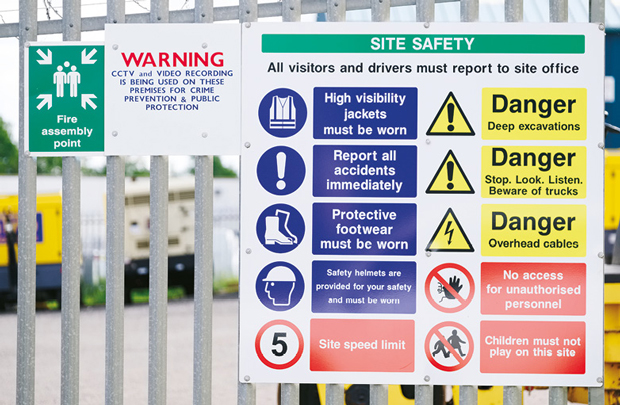Good signs ahead

Ensuring safety in the workplace is essential. According to figures from the Health and Safety Executive (HSE), in 2020/21 there were 142 workplace fatalities and 441,000 self-reported workplace injuries, including 102,000 that resulted in an absence from work that lasted more than seven days. There are also an estimated 17,000 new cases of breathing or lung problems caused or worsened by work each year and approximately 12,000 lung disease deaths linked to past exposures at work. The latest Cost to Britain analysis carried out by the HSE suggests that the annual financial impact of workplace illness and injury could be as much as £16.2 billion.
SIGNAGE REGULATIONS
The Health and Safety (Safety Signs and Signals) Regulations 1996 applies in England, Scotland and Wales to all places of work covered by the Health and Safety at Work Act 1974. The Regulations require employers, as well as duty-holders and those who have responsibility for the premises, to ensure that safety signs are in place and maintained where there is a significant risk to health and safety that has not been removed or controlled by other methods. It relates specifically to ensuring the safety of employees and does not apply to non-employees such as visitors to the building. However, other regulations, including the Health and Safety at Work Act 1974 do include a duty of care to members of the public. Therefore, effective safety signage can also help to ensure compliance in this area.
In addition, fire legislation, such as the Regulatory Reform (Fire Safety) Order 2005 in England and Wales and the Fire (Scotland) Act 2005 in Scotland, also includes duties and provisions that must be considered when selecting and installing emergency exit and firefighting equipment signage.
To determine what signage is required, employers must carry out a risk assessment to identify hazards, the risks those hazards present and the control measures to be taken to mitigate these risks. If there is still a significant risk once this process has been completed, then safety signs should be used to warn employees of the hazard or provide instruction on the further measures they should take. The regulations make it clear that signage should not be considered a substitute for other measures such as engineering controls or safe working practices. The regulations also cover the use of acoustic, verbal and hand signals where these are appropriate.
Furthermore, there is an element of training and instruction required. It is important for employees to be aware of and understand the meaning of safety signs and signals either seen or heard during their work. Although most safety signs are self-explanatory, this does not guarantee that all employees, especially those who are less experienced, will recognise some of the less common symbols. For example, although toxic material or radioactive warning signs are generally recognisable, others such as those that warn of the presence of laser beam generating equipment may not be. Therefore, a small amount of supplementary text alongside the sign may be helpful to ensure full understanding.
Danny Adamson, Managing Director at Stocksigns looks at the relevant regulations for workplace signage and provides guidance on how facilities managers can ensure they comply
The post Good signs ahead appeared first on FMJ.

